Growth in Population
One of the major causes of the Industrial Revolution is the growth in population. Britain witnessed tremendous changes during the first Industrial Revolution, including scientific breakthroughs, increased gross national product, new technologies, and architectural innovation. At the same time, the population grew, becoming more urbanized, healthier, and educated.
According to Wilde, immigration from rural areas of the United Kingdom and foreign countries contributed to a continuous rise in population as the Industrial Revolution began. This expansion provided cities with the workforces they badly needed to keep up with new innovations, allowing the revolution to last several decades. Job possibilities, greater pay, and improved nutrition drew people together to form new urban cultures.
According to historical studies, the population of England remained largely static and expanded very little between 1700 and 1750, in the years preceding the Industrial Revolution. There are no precise figures for the era preceding the establishment of a nationwide census, but known historical documents show that Britain underwent a demographic explosion in the latter half of the century. According to some estimates, the population of England more than doubled between 1750 and 1850. The growing population aided the Industrial Revolution significantly. It increased demand for food and other commodities (like cloth). The growing population also aided in filling the numerous new jobs produced by the Industrial Revolution.










